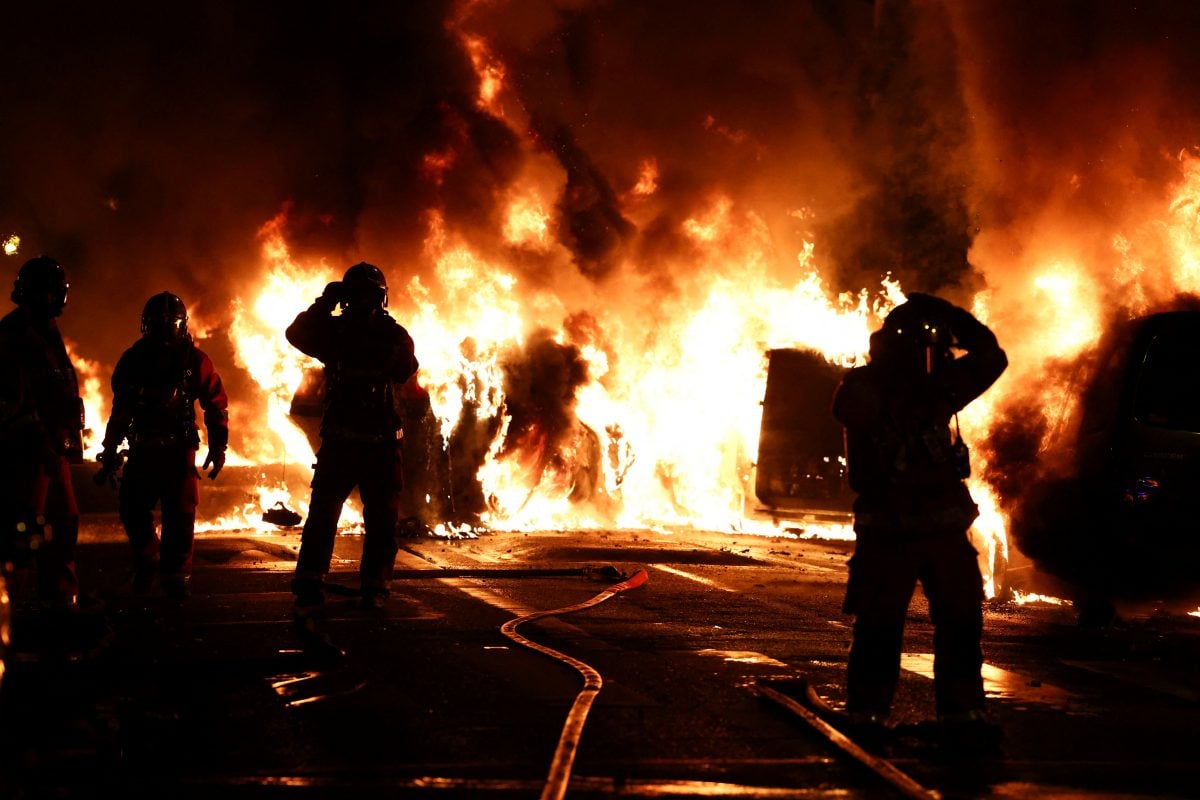NANTERRE, France, (Reuters) – President Emmanuel Macron battled to contain a mounting crisis today after riots spread across France overnight, set off by the deadly police shooting of a teenager of North African descent during a traffic stop in a Paris suburb.
Police made 180 arrests during a second night of unrest, Interior Minister Gerald Darmanin said, as public anger spilled onto the streets in towns and cities across the country.
Macron held a crisis meeting with senior ministers over the shooting, after which Prime Minister Elisabeth Borne dismissed calls from some political opponents for a state of emergency to be declared.
Darmanin said 40,000 police officers would on Thursday be deployed across the country — nearly four times the numbers mobilised the previous day — including 5,000 in the Paris region in a bid to quell the unrest.
“The response of the state must be extremely firm,” Darmanin said, speaking from the northern town of Mons-en-Baroeul where several municipal buildings were set alight.
The incident has fed longstanding complaints of police violence and systemic racism inside law enforcement agencies from rights groups and within the low-income, racially mixed suburbs that ring major cities in France.
The shooting of the 17-year-old, identified as Nahel, took place in Nanterre, on the western outskirts of Paris. The local prosecutor said the officer involved had been put under formal investigation for voluntary homicide.
Under France’s legal system, being placed under formal investigation is akin to being charged in Anglo-Saxon jurisdictions.
“The public prosecutor considers that the legal conditions for using the weapon have not been met,” Pascal Prache, the prosecutor, told a news conference.
VIGIL MARCH
At a march in Nanterre in memory of Nahel, participants railed against what they perceived as a culture of police impunity and a failure to reform law enforcement in a country that has experienced waves of rioting and protests over police conduct.
“We demand that the judiciary does its job, otherwise we’ll do it our way,” a neighbour of Nahel’s family told Reuters at the march.
Thousands thronged the streets. Riding atop a flatbed lorry, the teenager’s mother waved to the crowd wearing a white t-shirt reading “Justice for Nahel” with the date of his death below.
A video shared on social media, verified by Reuters, shows two police officers beside a Mercedes AMG car, with one shooting at the teenage driver at close range as he pulled away. He died shortly afterwards from his wounds.
The Nanterre prosecutor said the police officer who fired the shot told investigators he had done so to prevent the teenager from fleeing after committing several traffic violations and because he was worried for his safety and that of the public.
The Nanterre prosecutor said he was known to police for previously failing to comply with a traffic stop orders.
Macron on Wednesday said the shooting was unforgivable. As he convened his emergency meeting he also condemned the unrest.
TORCHED CARS
The unrest has revived memories of riots in 2005 that convulsed France for three weeks and forced then-president Jacques Chirac to declare a state of emergency.
That wave of violence erupted in the Paris suburb of Clichy-sous-Bois and spread across the country following the death of two young people electrocuted in a power substation as they hid from police.
Two officers were acquitted in a trial ten years later.
Tuesday’s killing was the third fatal shooting during traffic stops in France so far in 2023, down from a record 13 last year, a spokesperson for the national police said.
There were three such killings in 2021 and two in 2020, according to a Reuters tally, which shows the majority of victims since 2017 were Black or of Arab origin.
Karima Khartim, a local councillor in Blanc Mesnil north east of Paris said people’s patience was running thin.
“We’ve experienced this injustice many times before,” he said.

